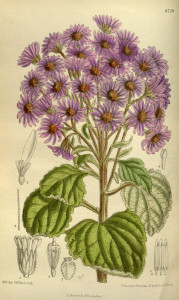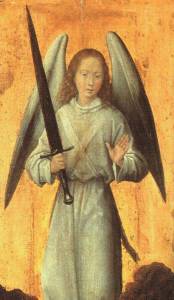The 29th of September brings Michaelmas, the Feast of St. Michael the Archangel, one of the principal angelic warriors. Asters, the lovely autumnal flower blooming now in northern places, are important to the day. The purple blossoms herald the end of summer, the approach of winter. Indeed, our days grow shorter and shorter and darkness advances now that we are past the autumnal equinox. It is a good time to seek the protection of Michael the Archangel.
St. Michael’s Bannocks are baked in Scotland and Ireland for Michaelmas. A bannock is not so unlike a scone: a flatbread, basically, cut into wedges, typically made from some combination of oats, barley, and rye. It’s traditional to eat the Michaelmas bannocks with blackberries or blackberry jam, for here is how the story goes: St. Michael the Archangel battled Satan, and as he fell to earth from heaven, Satan fell directly into a bramble patch. Have you ever been in a bramble patch? The blackberries are irresistible, but the thorns on the plants can leave you a bloody mess. Legend has it that each year, Satan returns to curse and spit upon the brambles that he landed upon.
Although Michaelmas celebrates Michael the Archangel, it is a day to celebrate angels of all kinds, the whole company of them, across cultures. Music is such a big part of the seasonal round of the year and I so rarely mention that, but I’m beginning to think I should. It’s good to have a soundtrack to our days. Jane Siberry wrote perhaps the best song ever to honor and invoke angels. It’s called “Calling All Angels,” and she recorded it as a duet with k.d. lang for Jane’s 1993 album “When I Was a Boy.” And so here, for you for Michaelmas, are two of my favorite Canadians singing the song live in Houston. It’s a homemade video, filmed by someone who was there in the audience that night, and in the very last few frames of the video, a woman in the audience turns to the camera and it is in those last few seconds that we witness the emotional power of a song, of a poem. This is what it’s all about, isn’t it? Connexions across time and space, whether human or angelic. The effect we have on others is entirely up to each and every one of us.
Image: Aster fuscescens, printed in Curtis’s Botanical Magazine, London, vol. 143, 1917. [Public domain] via Wikimedia Commons.

